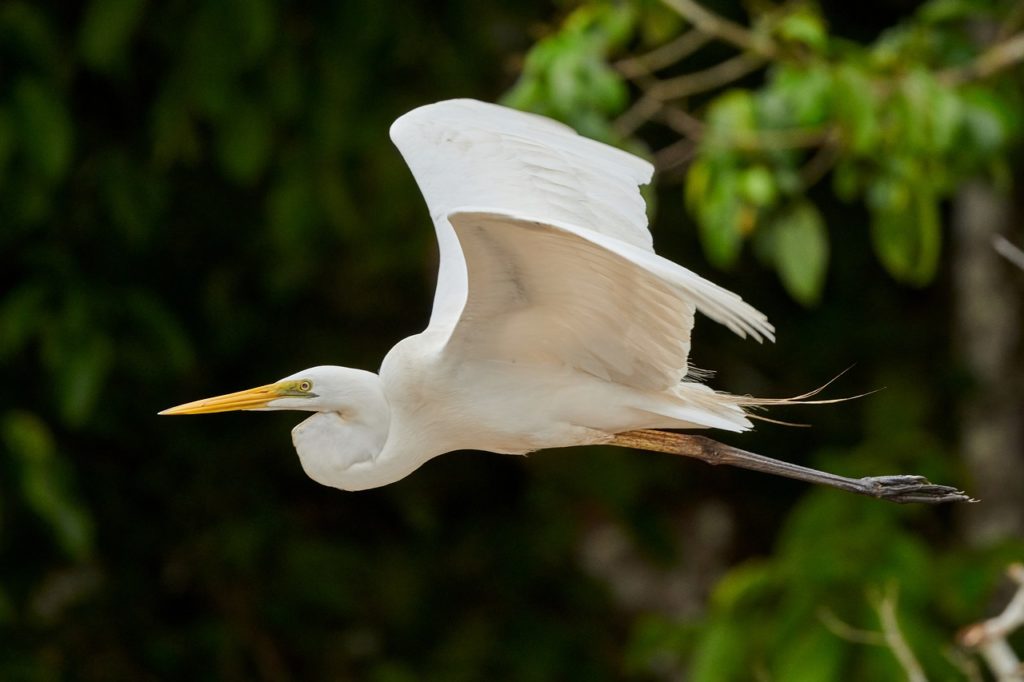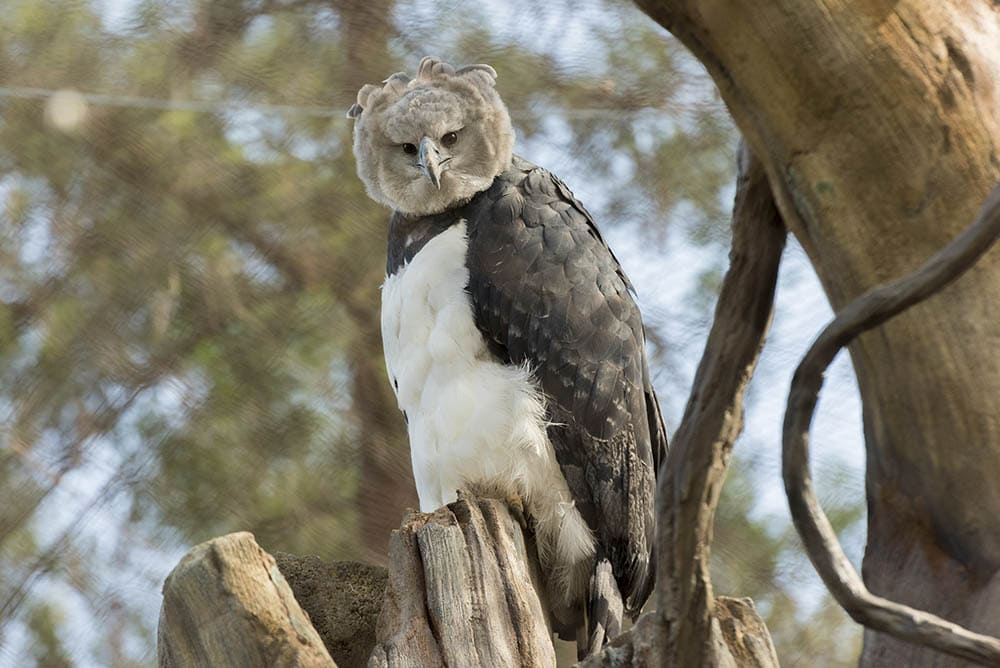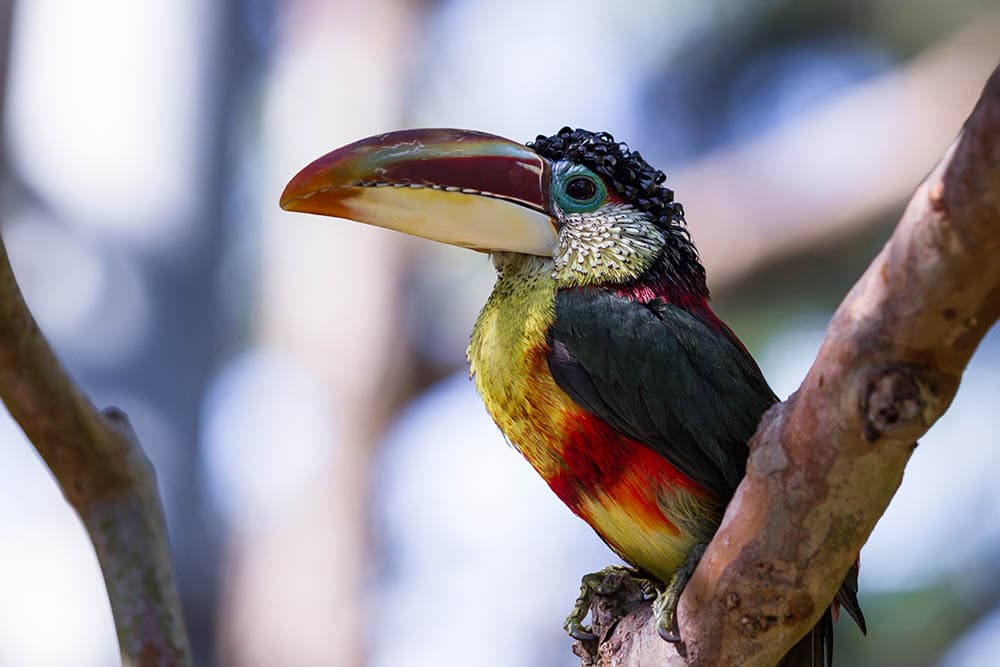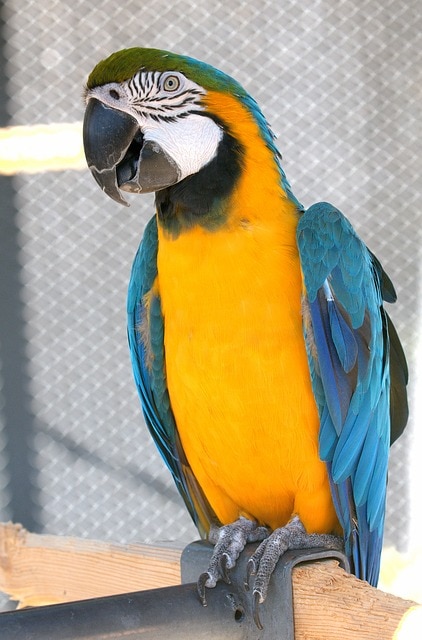9 Fascinating Rainforest Birds (With Pictures)
Last Updated on

Rainforests are special in so many ways. They are literally our planet’s lungs, in the sense that they absorb most of the greenhouse gases released to the atmosphere by us humans and give back oxygen. This process is important because it not only makes sure that we have a steady supply of essential air for survival, but also stabilizes the Earth’s climate.
And that’s not all, as they are also responsible for rainfall that’s crucial for the growth, health, and good condition of plants and animals. Speaking of, did you know they are often considered home to a wide variety of bird species? Let’s talk about those for a minute:

The 9 Most Common Rainforest Birds
1. Spix’s Guan

If you’ve ever taken a trip to the Amazon, you’ve heard some yelping bark-like calls originating from those canopies. And yes, we know the Amazon is filled with strange noises coming from everywhere, but the one produced by the Spix’s Guan is very distinctive. So distinctive that you cannot mistake it for any other bird call.
When it comes to appearance, it’s easy to confuse the Spix’s Guan for a turkey owing to the fact that they pretty much have the same physical attributes. And by the way, we’re not referring to an adult turkey, but the juveniles. The adult turkey kind of looks too buff for a Spix’s Guan.
Anyway, this species is a tree-dwelling bird, and that’s why ornithologists like to refer to it as the arboreal bird. They all have a gorgeous-looking loose flap of red skin at the chin, also known as the dewlap, and a plumage that’s brown-ish or blue-ish in color.
The Spix’s Guan is a diurnal bird. It’s very active during the day, and dormant at night. They sometimes like to make these strange, annoying calling noises at night. We don’t know what that’s all about, and something tells us that they don’t either.
Spix’s Guans hate humans. They’ve over the years evolved and are now well aware of the fact that humans represent danger. That’s why you’ll see them all fly away the moment one of them spots a human passing by. Even if the same human doesn’t show any interest in them.
It belongs to the Cracidae bird family, so you should expect its wings to make some rattling noises — This is typical of a Cracidae species.
If you’ve ever heard that noise before, you’ll know one of two things is happening: It’s either stretching out at the crack of dawn or trying to woo a mate. But often, it’s the former.
How did this bird get such an incredible name?
It got it from one, Dr. Johan Ritter Von Spix. He was a prominent ornithologist who dedicated most of his life to saving different bird species that were facing extinction. Seeing as he was the guy who managed to collect the very first specimen of the species, it only felt right to name the bird after him.
2. Great Egret

Anytime we talk about the Great egret, a lot of you think that we’re referring to the Great White Heron. But these two birds are so different.
For starters, if you’re an avid bird watcher, you’ll realize the Great Egret is a tad bit smaller in size. And if you can’t see that, just shift your focus to their legs. You’ll see that the legs of the Great Egret are always darker than those of the Great White Heron.
The other dead giveaway is the shaggy feather situation on the Heron’s breast — Not to mention the heavy-looking bill.
The Great Egret has the same feeding behavior as its kinsmen. It’s classified as an omnivore, meaning it will willingly feed on anything from grasshoppers, shrimps, reptiles, amphibians, and crayfish, all the way to small mammals and birds.
Something else worth taking note of is its hunting methods. They are just as flexible as its diet, and one of the best in the game.
There will be times when all it does is just sit and wait for prey to approach. But if it’s too tired of waiting, or growing impatient, it will try its luck in the shallow waters. Foraging is also an option, and they’ll either do that alone, or in groups.
Now that we’ve mentioned it, if we were you, we wouldn’t try to get close to them while they are busy hunting. Especially if they happen to be in a large group.
You see, the thing is, this species is annoyingly territorial and aggressive, and they won’t have any problem letting you know. If you don’t back off at the first warning sign, they keep screaming, and even go as far as attacking you using their sharp bills.
Moving on, the Great Egret is a monogamous species. But they are seasonally monogamous, as they’ll pair up with a different mate every breeding season. Their nestlings love to compete for the food served to them by their parents, and the competition is so fierce that they’ll sometimes kill their weaker siblings.
3. Laughing Falcon

The falcon is one of those birds that had to be named after its distinctive call. We kid you not when we say this species could easily make you believe that the rainforest is a place haunted by ghosts. It can produce noises that sound EXACTLY like human laughter, and that’s something that could creep anybody out.
In some circles, it’s referred to as the snake hawk. And that’s primarily because it loves hunting down snakes more than anything else. Also, the name snake hawk means exactly what you’re thinking — It’s a member of the hawk family.
If you saw the way the Laughing falcon hunted down its prey, you’ll thank the gods you were born human. Typical of a bird of prey, it often dives down and lands heavily right on top of the snake’s head.
That force is sometimes too much that the snake’s head ends up being decapitated in the process. The bird will then carry both the head and the lifeless body to a perch nearby and tear it all to shreds before consuming it.
The Laughing falcon does not discriminate when it comes to the type of snakes it hunts down. And that’s why you’ll see it feed on a non-venomous snake one minute, and a venomous one the next. If snakes are not available, it will settle for the next best thing, which is the lizard.
Identifying the Laughing falcon is quite easy. Just look for a bird that looks like it’s wearing a black mask and has a brown-ish-buff underpart. The upper-tail covert will have the same color as its chest and head, which is buff-white.
Another way of identifying it is by observing its general behavior. Unlike all the other bird species in the rainforest, it’s usually slow-moving. In addition, they seldom build nests and only do so if they haven’t found one that’s abandoned.
What do they fear the most? Tayras and Spider monkeys. These two are considered their main predators, as they like to raid their sites looking for chicks or eggs.
4. Harpy Eagle

We don’t know if this is something that you’ve realized yet, but the one question that keeps popping up anytime anybody types the words “Harpy Eagle” on a search engine, is whether it’s strong enough to steal a toddler. And to be honest, we don’t know.
The only thing that we can say for sure is, this 20-pound bird has enough strength to lift a 17-pound prey. In fact, that’s why they usually feel comfortable preying on monkeys and sloths that are obviously too slow to outrun them.
The female Harpys tend to go for larger prey and leave the smaller one to their male counterparts because they enjoy the size advantage. Hunting down a reptile might seem like a herculean task for a male Harpy, but child’s play to the female. So, if the monkey and sloth population drastically declines in the area, they’ll start feeding on reptiles and other birds.
The Harpy eagle is what we like to refer to as the “Silent Hunter.” You’ll never see them soaring or flying while hunting for food. They’ll just be perched on a branch for hours, and silently wait for a meal to walk by. The minute they spot one, they’ll use that 50-miles-per-hour speed of theirs to swoop down and snatch it.
Why call it the Harpy?
Greek mythology enthusiasts are better poised to answer this question for you. Apparently, there was a mythological creature called the Harpy, and it possessed all the attributes seen in the Harpy eagle. It was strong, had powerful wings, and an incredibly sharp bill.
The Harpy eagle is a close cousin to the Crested eagle and the New Guinea eagle — together, they make up the Harpiinae subfamily. Its whole back is jet black, and the belly is largely white. We say ‘largely’ because there’s a very visible black band across its upper torso that separates the white from their gray head plumage.
This species mates for life and is believed to have a lifespan of 25 to 35 years. They often get to sexual maturity at the age of 4 or 5, and only lay two eggs per breeding season. The egg that hatches first will be the egg that will be taken care of. The remaining one will be ignored and be left to go bad.
5. Long-whiskered Owlet
https://www.instagram.com/p/CHHRlAmgNDV/
If by any chance you’re wondering why this species made the list even though you’ve never heard of it before, just know it’s because it’s endemic to certain regions. You cannot just walk into a rainforest and spot a Long-whiskered Owlet. You first must know where they are found, and then talk to a native who understands the bird’s behavior.
The most recent reported sighting came from San Martin in Peru, and the Andean mountains. Researchers say its most preferred habitat is one that comes with air plants (epiphytes) that are 6,200-7,220 ft above sea level, and cloud forests characterized by dense undergrowths.
The Long-whiskered Owlet is not just one of the rarest owls in the world; it’s also one of the smallest. With a length of 5-5.5 inches, it’s safe to assume this bird is smaller than the size of an average human fist. The genus name for the Long-whiskered owlet is Xenoglaux loweryi. And its literal translation is “Strange Owl.”
Before 1976, nobody knew the Long-whiskered owlet existed. It was only discovered when its specimen was caught in one of the traps meant to catch a different specimen. Because it was so rare, tiny, and unusual, the conservationists working with a group of scientists at the time decided to give it the genus Xenoglaux loweryi.
As of now, scientists believe that we only have about 1000 tiny animal species that are still alive, belonging to the genus Xenoglaux. The only reason why there is so little information about the Long-whiskered owlet is because they are so rare and hard to find.
Usually, you have to study more than one bird to find a pattern in their behavior. So, if you cannot get enough specimens, you’ll never be able to draw conclusions. Also, the bird had to be classified as an endangered species, as there are very few records about them that currently exist.
Related Read: 53 Fascinating & Fun Owl Facts You Never Knew
6. Curl-Crested Aracari

There’s a debate that has been raging on for what feels like a century now. Those responsible for scientifically naming our plants and animals have been going at it, trying to figure out how the scientific name for the Curl-crested should be spelled.
The other half prefers the spelling to be Pteroglossus beauharnaesii, while the rest believe Pteroglossus beauharnaisii looks like the correct spelling. If you take a quick look at what the Zoological Nomenclature International Code says, you’ll learn the latter was the name first given to the species, but it hasn’t been used for over fifty years — Thereby making the former, the current official name.
Moving forward, the ‘Curl’ in Curl-Crested is in reference to its curly head feathers that are sometimes referred to as the crown. It’s important to also note the fact that the species is a South American bird, and another rare species. Conservationists say it’s so rare that most people who’ve been fortunate enough to live within its range have never seen it before.
When it comes to size, the Curl-crested aracari is most definitely the second largest aracari, after the Chestnut Eared Aracari. But if the conversation is about which among them is exquisitely beautiful or attractive, we’ll have to give it to the Curl-crested Aracari.
These birds are very peaceful and social, and that’s why they get along with almost every other species. Very little is known about their diets, but researchers do believe that they live mostly on fruits such as figs. Of course, they’ve been instances where they’ve been spotted preying on the eggs and even nestlings of the yellow-rumped cacique, but that only happens during their breeding season.
Their babies are always born blind and naked, with features that look like thick pads on their heels. This could be an adaptation to protect the chick from the rough floor of the nesting site, seeing as their parents never build nests. They’ll just lay their eggs in anything that looks or feels hollow enough.
7. Blue and Gold Macaw

Everybody knows that the Blue and Gold Macaw is a rainforest species, because ornithologists usually call South America its native home. South America, for those who’ve forgotten, is a continent in the Western Hemisphere that’s significantly covered with rainforest.
The species is so common that it could pay you a visit anytime. But that’s only if you’re a resident in Panama, Colombia, Bolivia, Paraguay, or Ecuador. A while back, we had Trinidad and Tobago on the list of countries that offer residence to the Blue and Gold Macaw, but the breeding population in that country suddenly went extinct.
The bird will only breed during the first half of the year, and they are monogamous in nature. Sadly though, finding a mate is not as easy as it always is with other species. We learned that this bird is usually more interested in the physical appearance of its potential mate, than anything else. When it’s time to choose a mate, the brightly colored males will have an easier time as compared to the ones that appear “dull”.
A female Blue and Gold Macaw will lay two to three eggs per season. The incubation period will be 28 days, during which the male will be responsible for protecting the nest. Once the chicks hatch, they’ll be fed regurgitated food. They are often blind and featherless during those first weeks, and that’s why they often rely on their mother to offer warmth and food.
Unfortunately, not all of them survive or move on to the juvenile stage. The data collected by conservationists in those places indicate that only one chick gets to survive and is taken care of by its parents until it feels ready to leave the nest.
Related Read: 15 Bird Documentaries and Movies Worth Watching this year
8. Common Potoo

This species is part of the Nyctibiidae Family, and is a nocturnal bird. They like to breed in open woodlands, and love to hang out near the edges of the rainforest.
The Common Potoo will practically survive anywhere if the conditions aren’t too extreme. So, if you take them to places such as the montane areas, they’ll just… fade away. Montane areas are areas characterized by high altitudes, but not high enough to limit the growth of various plants and animals.
Specimens collected in the past have led researchers to believe that they naturally thrive in countries like Uruguay, Costa Rica, and Argentina. So, it’s safe to assume that they find the climate in these regions perfect for breeding, and building homes.
We’ve already told you that the Common Potoo is a nocturnal species, but what we haven’t told you yet, is what they love to hunt. And the answer is insects. They are classified as insectivores and will prey as soon as the sun goes down.
With the help of a night vision device, you’ll be able to see them perched on low branches with their mouths wide open. Because they normally have eyes that are adapted to reflecting light, any insect flying by will be drawn to them just the same way they’re drawn to different light sources. And once they get closer, they become dinner.
It’s almost impossible to spot a Common Potoo during the day. It will be perched at the highest point of the tree and stay motionless all day long. Its cryptic plumage doesn’t help either, as they usually have colors that blend in well with the branches.
Common Potoos are territorial birds. They might not be as aggressive as other species, but if you keep pushing, they’ll use anything at their disposal to protect their territories, nests, and chicks.
9. Spectacled Owl

The bird is famously known as the Spectacle owl because it looks as though it’s wearing a pair. It has white feathers circling its eyes and a plumage that’s largely dark brown in color. The only areas with a different color are the abdomen and breast.
Our Spectacle friend prefers living in the tropical rainforest, and its breeding population is evenly distributed in Northern South America and Central. They are usually inactive during the day, and very active at night. Hence, nocturnal in nature.
The noises or sounds produced by the female are very different from that of the male, so as to make it easier for the male to pinpoint their exact location during mating season.
A Spectacled owl’s diet is mainly insects and mice. They’ll catch the mice using the same strategy that most birds of prey use, and just pluck insects from the vegetation around them. But if they feel a little bit energetic, or wish to have something different, they’ll go for a larger mammal like the possum.
Their breeding populations are relatively high, and we don’t think that’s going to change any time soon. Most of those countries have now made it illegal to hunt birds in those forests.

In Conclusion
So, these are the bird species that like to call the tropical rainforests home. Obviously, the list is endless, but we found these to be quite fascinating. Some of them have been listed as ‘Species of Least Concern’, while others are endangered. Try to learn more about the endangered species, and do whatever you can to help us, help them.
You might also be interested in:
Featured Image Credit: Pixabay
About the Author Robert Sparks
Robert’s obsession with all things optical started early in life, when his optician father would bring home prototypes for Robert to play with. Nowadays, Robert is dedicated to helping others find the right optics for their needs. His hobbies include astronomy, astrophysics, and model building. Originally from Newark, NJ, he resides in Santa Fe, New Mexico, where the nighttime skies are filled with glittering stars.
Related Articles:
Monocular vs Telescope: Differences Explained (With Pictures)
How to Clean a Refractor Telescope: Step-by-Step Guide
How to Clean a Telescope Eyepiece: Step-by-Step Guide
How to Clean a Rifle Scope: 8 Expert Tips
What Is a Monocular Used For? 8 Common Functions
How to Clean a Telescope Mirror: 8 Expert Tips
Brightfield vs Phase Contrast Microscopy: The Differences Explained
SkyCamHD Drone Review: Pros, Cons, FAQ, & Verdict
